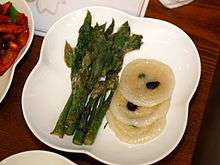Aralia elata
| Aralia elata | |
|---|---|
 | |
| Scientific classification | |
| Kingdom: | Plantae |
| (unranked): | Angiosperms |
| (unranked): | Eudicots |
| (unranked): | Asterids |
| Order: | Apiales |
| Family: | Araliaceae |
| Genus: | Aralia |
| Species: | A. elata |
| Binomial name | |
| Aralia elata (Miq.) Seem., 1868 | |
Aralia elata, or Japanese angelica-tree,[1] is a woody plant belonging to the family Araliaceae.
Description
It is an upright deciduous small tree or shrub growing up to 10 m (33 ft) in height,[2] native to eastern Russia, China, Korea, and Japan.
In Japan it is known as tara-no-ki (Katakana: タラノキ/Kanji: 楤木), and in Korea as dureup namu (두릅나무). It prefers deep loamy soils in partial shade, but will grow in poorer soils and in full sun. The plant is sometimes cultivated, often in a variegated form, for its exotic appearance.
The bark is rough and gray with prickles. The leaves are alternate, large, 60–120 cm long, and double pinnate. The flowers are produced in large umbels in late summer, each flower small and white. The fruit is a small black drupe.
Aralia elata is closely related to the American species Aralia spinosa, with which it is easily confused.
Gastronomy

In Japan, the shoots (taranome) are eaten in the spring. They are picked from the end of the branches and are fried in a tempura batter.
In Korean cuisine, its shoots called dureup are used for various dishes, such as dureup jeon (두릅전), that is a variety of jeon (pancake-like dish) made by pan-frying the shoots covered with minced beef and batter.[3]
Dureup namul (두릅나물), also called dureup muchim (두릅무침) is a dish made by blanching dureup seasoned with chojang (chili pepper and vinegar sauce).[4]
It is also common to eat Aralia elata as Dureup bugak (두릅부각), fried shoots of the plant coated with glutinous rice paste, usually served along with chal jeonbyeong (찰전병), a kind of pancake made by pan-frying glutinous rice flour.
Invasive species
The tree was introduced in 1830 in the United States. Birds like the fruits and are spreading its seeds allowing the tree to expand as an invasive species in the Northeastern United States.[5]
References
- ↑ "BSBI List 2007" (xls). Botanical Society of Britain and Ireland. Archived from the original on 2015-02-25. Retrieved 2014-10-17.
- ↑ "RHS Plant Selector - Aralia elata". Retrieved 29 May 2013.
- ↑ 두릅전 (in Korean). Doosan Encyclopedia.
- ↑ 두릅 (in Korean). Doosan Encyclopedia.
- ↑ U.S. Dept. of Agriculture: Map of distribution in U.S. and Canada